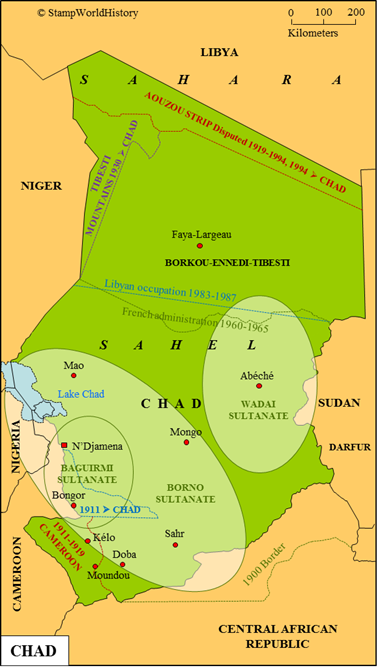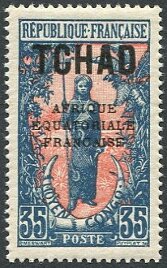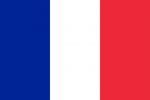
Chad
French possession
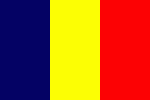
Chad
Republic
Quick reference
General issues: French colony 1922-1936, French colony, self government 1959-1960, Republic 1960-Present
Country name on general issues: Tchad
Currency: 1 Franc = 100 Centimes 1922-1960, 1 (CFA) Franc = 100 Centimes 1960-Present
Population: 1 339 000 in 1925, 10 329 000 in 2009
Political history Chad
Introduction
Chad is located in central Africa. The population consists of many different Nilo-Saharan peoples of which the Sara are the largest group. A smaller part of the population is of Afro-Asiatic – Arabian – origin. The population is concentrated in the southern part of the country. In the 19th century the most notable polities are the sultanates of Wadai and of Baguirmi. In the late 19th century, a large part of the future Chad – including the sultanate of Baguirmi – is overrun by Rabih az-Zubayr – a warlord originating from Sudan. In 1893, Rabih az-Zubayr ascends to the title of sultan of Borno. Europeans first explored Chad in the early 19th century – reaching Lake Chad in the 1820’s.
Establishing the French presence
The French, from their existing possessions in central Africa, send expeditions into the future Chad from 1891, signing treaties of protection. In 1900, the French face Rabih az-Zubayr in battle. Rabih az-Zubayr is defeated and dies in battle, ending the presence of the Borno sultanate in Chad. The French, in 1900, proclaim Chad to be a French military territory. The Baguirmi sultanate has, by then, already signed a treaty of protection with the French. The Wadai sultanate follows suit in 1909. All in all it will take the French until 1920 to gain control of Chad.
Establishing the borders
The borders of Chad with neighboring Cameroon and Sudan are established in 1894 and 1899 respectively. The border with Cameroon is adjusted in 1911 and again in 1919. In 1911, the French transfer part of French Equatorial Africa – including part of Chad – to German Cameroon as a result of the treaty of Fez – one of the treaties leading up to the establishment of a French protectorate over Morocco. Conversely, part of Cameroon is ceded to Chad. In 1919, after WWI, the part of Chad ceded to Cameroon is returned to the French. The border with Libya is first established in 1890, but will be disputed between 1919 and 1994 – the so called Aouzou strip changing hands several times. In 1994, the Aouzou strip is officially awarded to Chad.
The border with Niger – then French Niger, part of French West Africa – is defined as we know it now in 1930 when the Tibesti Mountains are transferred from Niger to Chad. Finally, the border with what is then Ubangi-Shari – currently the Central African Republic – has been frequently adjusted. In 1900, the border is first drawn – the border as we know it until today is established in 1936.
French colonial administration
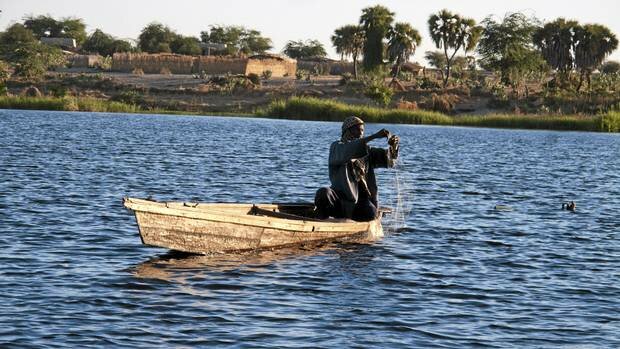
A fisherman on Lake Chad. Lake Chad has since the 1960’s been greatly reduced in size because of desertification caused by overgrazing, irrigation projects tapping from the feeding rivers, long periods of drought in the Sahel and shifting climate patterns.
As part of the French possessions in central Africa, Chad will go through a number of administrative changes. In 1903 – effective 1904 – the French possessions in central Africa are grouped together as the federation of French Congo then consisting of the colonies of Gabon and Middle Congo – the current Congo Brazzaville, the French territory of Ubangi-Shari and the French military territory of Chad. In 1906, Chad is joined with Ubangi-Shari to form Ubangi-Shari-Chad. The federation of French Congo is, in 1910, renamed French Equatorial Africa. Ubangi-Shari-Chad is finally split up again in 1914 now forming the colony of Ubangi-Shari and the territory of Chad. In 1920, the territory of Chad is elevated to the status of the colony of Chad.
The French establish effective colonial rule, mainly in the south. In the north, French presence is limited – indirect rule being the predominant form of administration. Cotton is introduced in the south as a cash crop.
In 1946, Chad becomes – as do all French possessions – a French overseas territory. From the 1940’s, Chad moves towards independence. In 1958, self government is gained as the republic of Chad. Chad gains full independence in 1960. The Borkou-Ennedi-Tibesti region will – under the sovereignty of Chad – be administered by the French until 1965.
Independent Chad
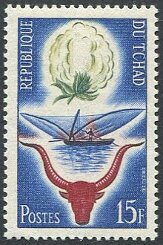
1959 – First anniversary of the republic of Chad. An allegory ‘Birth of the republic’ showing cotton, a fishing boat and a gazelle.
After independence, Chad will, from 1966, be engulfed in civil war. In the process the French intervene a number of times on behalf of the government. Libya is involved on the opposition side. Libya in 1973 occupies the Aouzou strip – annexed in 1976 – and from 1983 to 1987 occupies the whole northern part of Chad. Finally, in 1987, the French oust the Libyans. In 1990, a peace accord is signed to end the civil war. The Aouzou strip is formally recognized by Libya to be part of Chad in 1994.
The peace accord has not resulted in political stability. Between 1998 and 2001, militias in the Tibesti region rebel against the government in N’Djamena. In the 2000’s, the conflict in Darfur in neighboring Sudan spills over into Chad – militias fighting the government and each other, relations with Sudan being strained. By 2010, the militias are largely subdued and relations with Sudan normalized. In 2014, elections are held that ‘international observers described as proceeding without incident’.
The Chad economy is a subsistence economy based on agriculture. Cotton is still the most important cash crop. Oil is the most important export product. Chad is one of the least developed countries in the world: on the Human Development Index Chad ranks 184 out of 187 countries.
Postal history Chad
The colonial era
The first post offices in Chad are opened in 1905 in Fort Archambault[1]The current Sahr. and Fort Lamy[2]The current N’Djamena. . The first stamps used are the stamps of the colony of French Congo – the predecessor of the federation of French Congo. As the federation of French Congo is formed in 1904, both Ubangi-Shari and Chad are to be postally administered from Middle Congo and stamps of Middle Congo are put into use in Chad from 1907. In 1915, the postal administration is transferred to Ubangi-Shari – the postal administration of Ubangi-Shari also including Chad. Thus – although Ubangi-Shari and Chad have, in 1914, become separate political entities within French Equatorial Africa – from 1915 stamps are used from Ubangi-Shari-Chad.
Chad issues its first stamps in 1922. All general issues for Chad are overprints on stamps of Middle Congo – with the exception of one set issued in 1931 as part of an omnibus issue for France and the French possessions. The first set is issued in 1922 – the overprint reading ‘Tchad’. From 1924, stamps are issued with the additional overprint of ‘Afrique Equatoriale Française’. The stamps of Chad are, from 1936, superseded by the issues of French Equatorial Africa.
Independent Chad
Having gained self government, Chad will issue stamps from 1959 – the first issue commemorating the first anniversary of the establishment of the republic. Independent Chad will issue stamps from 1960. The stamps issued by Chad are, from the 1960’s to the 1980’s, a mix of themes of national interest and themes aimed at the thematic collectors market – many of the designs being in the French design tradition. From the 1990’s, the stamps issued are almost exclusively aimed at the thematic collectors market.
Album pages
← Previous page: Central African RepublicNext page: Ciskei →

